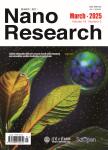版权所有:内蒙古大学图书馆 技术提供:维普资讯• 智图
内蒙古自治区呼和浩特市赛罕区大学西街235号 邮编: 010021

作者机构:Institute of Physics Chinese Academy of Sciences Beijing 100190 China School of Physical Sciences University of Chinese Academy of Sciences Beijing 100049 China Department of Chemistry University of Nebraska Lincoln NE 68588 USA Beijing Advanced Innovation Center for Soft Matter Science and Engineering Beijing University of Chemical Technology Beijing 100029 China
出 版 物:《Nano Research》 (纳米研究(英文版))
年 卷 期:2019年第12卷第3期
页 面:587-592页
核心收录:
基 金:support from Ministry of Science and Technology 国家自然科学基金 中国科学院项目
主 题:graphdiyne subnanopore molecular dynamics water transport desalination
摘 要:Ab initio and classical molecular dynamics simulations show that water can flow through graphdiyne—an experimentally fabricated graphene-like membrane with highly dense (2.4 × 10^18 pores/m^2), uniformly ordered, subnanometer pores (incircle diameter 0.57 nm and van der Waals area 0.06 nm^2). Water transports through subnanopores via a chemical-reaction-like activated process. The activated water flow can be precisely controlled through fine adjustment of working temperature and pressure. In contrast to a linear dependence on pressure for conventional membranes, here pressure directly modulates the activation energy, leading to a nonlinear water flow as a function of pressure. Consequently, high flux (1.6 L/Day/cm^2/MPa) with 100% salt rejection efficiency is achieved at reasonable temperatures and pressures, suggesting graphdiyne can serve as an excellent membrane for water desalination. We further show that to get through subnanopores water molecule must break redundant hydrogen bonds to form a two-hydrogen-bond transient structure. Our study unveils the principles and atomistic mechanism for water transport through pores in ultimate size limit, and offers new insights on water permeation through nanochannels, design of molecule sieving and nanofluidic manipulation.